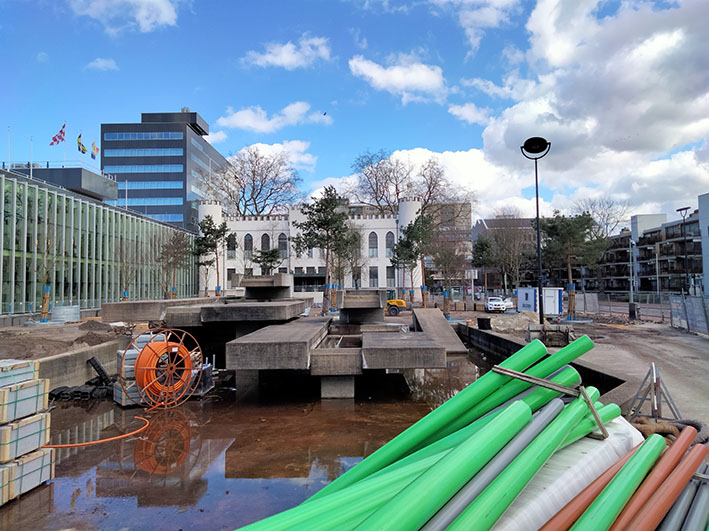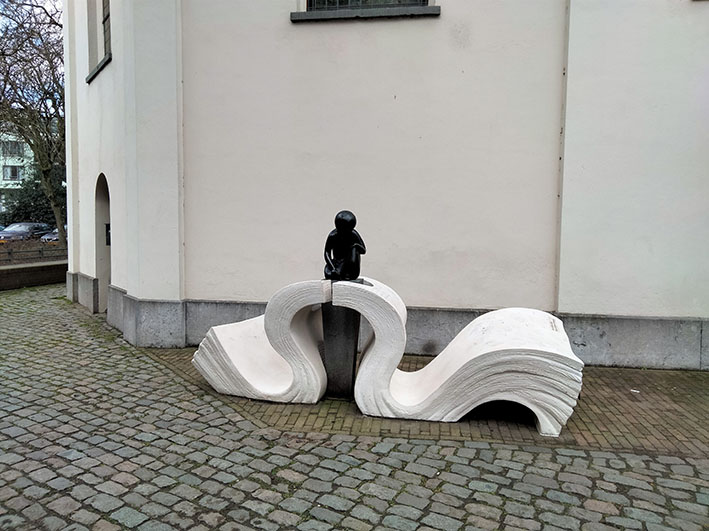Culture in Tilburg's public domain
On a cold, stormy Monday in March, Esther Didden cycled through Tilburg with Arno van Roosmalen, adviser on art in public spaces. They see many good and interesting works of art, including John Körmeling's Turning House doing its tour. Enough conversation material.

The Tilburg City Council feels the need to develop a new vision for culture in the public domain and has commissioned Van Roosmalen to flesh it out. In May, the Tilburg City Council will hopefully adopt this new vision. As an external consultant, Van Roosmalen is also concerned with so-called "ongoing issues" that involve existing works of art in the public domain. Think of restorations, re-placements and civic initiatives. There are several dozen of them.

If there is a new vision, it means that there are also old visions. Tilburg has always taken the lead in this. In 1983, Joost Baljeu (1925-1991) wrote the master plan for works of art in public space in Tilburg. From 2002 to 2011 there was the program KORT, with which Tilburg became a pioneer and an important reference for the policy on art in public space in the Netherlands. KORT stands for Kunstenplan Openbare Ruimte Tilburg, and focused not only on outdoor art in a spatial context, but also connected to social processes and cultural manifestations in the city. This was followed in 2016 by CuPuDo, an abbreviation of Culture in the Public Domain, an online platform containing all artworks in Tilburg's public space with the aim of letting everyone (re)discover the city and art. CuPuDo ended in 2019, but the website is still active and it is wonderful to browse through all those artworks.
The very concept of culture accounts for the fact that artistic expressions in public space have become more diverse in their manifestations
What is striking is the vision of culture in the public domain. Van Roosmalen explains that the very concept of culture accounts for the fact that artistic expressions in public space have become more diverse in their manifestations. Art can be temporary, interactive, have a theatrical aspect, and so on. By also choosing the term "public domain," he wants to indicate that public space extends beyond the mere physical space of streets, squares and parks. As far as he is concerned, it also includes publicly accessible buildings such as a train station or a theater, as well as digital public space.

The vision starts from the idea that art contributes to the collective ownership of a meaningful public space. Van Roosmalen sketches his ideal image of a public space that can and may be questioned again and again: by artists in practice, by citizens in daily life, by thinkers with ideaën and by administrators with an open mind. Art can hold its own very well in public space because it is the outcome of social processes, connects to social issues and, as mentioned, may be questioned by social players.
Two new city squares undergoing transition from traffic area to residential area in the coming years
With that ideal image in mind, we cycle through the center and look at the locations for which ZUS Architects designed: the Stadsforum and Koningsplein. Two new city squares that in the coming years will undergo the transition from traffic area to residential area. This means moving and restoring artworks. The work Metrøality by Marry Overtoom will return to public space; it has not been seen for ages and restoration is out of the question. In consultation with the artist, there will be an updated version of this disruptive artwork that suggests Tilburg has a subway system.
Van Roosmalen is enthusiastic about Beljon's two sculptures that stand in the center; the bus shelter and the fountain. Both artworks will remain in the future City Forum in almost the same location, after all, they are iconic and tell the viewer something about the history of art in public space. It is good if the new city square can soon tell multiple stories, if there is a certain layering in the perception of the place.
A collection that is constantly evolving
He also points to the project of Merel van der Linden Beeldschoon x The Writer. With temporary interventions she puts works of art in the spotlight, and sometimes invites another artist to do so. In Tilburg she worked together with Marieke Vromans; they devised an intervention for The Writer by Hein Koreman. They gave the sculpture a plaster roll of paper and passersby were allowed to write on it. Van Roosmalen finds it important and special that the municipality supports this kind of initiative. Temporary interventions, thought-provoking and disruptive works of art with international appeal, in his view it is part of the art collection for Tilburg. A collection that is constantly in motion.


